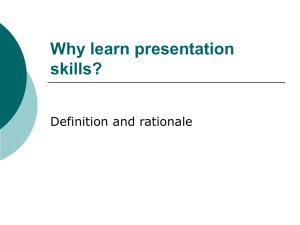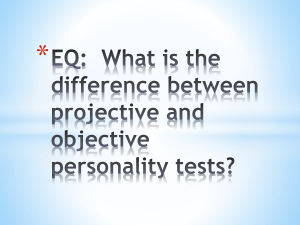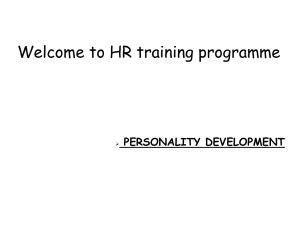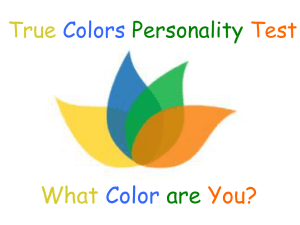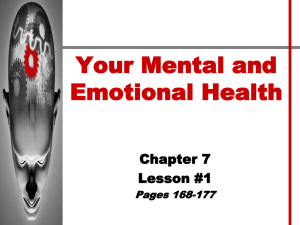ApsaA 2013 Research Presentation on Personality - Mmpi
advertisement
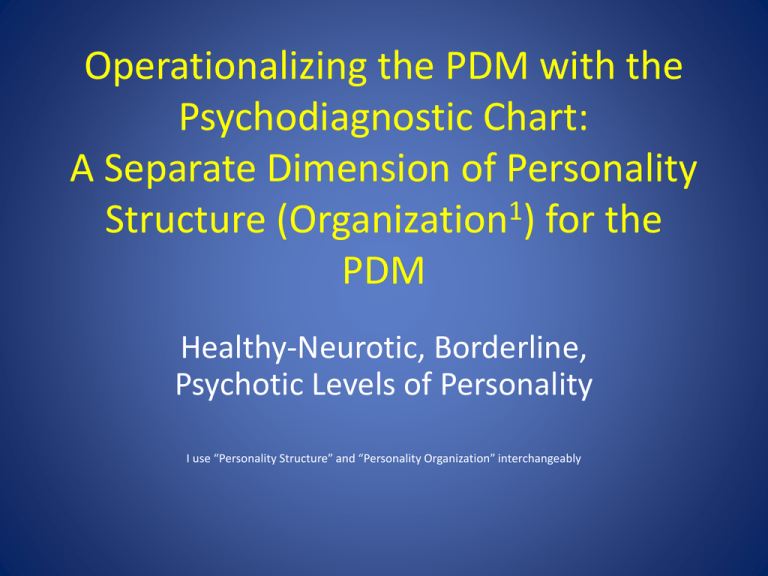
Operationalizing the PDM with the Psychodiagnostic Chart: A Separate Dimension of Personality Structure (Organization1) for the PDM Healthy-Neurotic, Borderline, Psychotic Levels of Personality I use “Personality Structure” and “Personality Organization” interchangeably PDM’s Current Taxonomy Personality Patterns and Disorders Mental Functioning Manifest Symptoms and Concerns What Do Psychologists Want From a Taxonomy? WHO Survey of 2155 Psychologists from 23 Countries Q9 - From your perspective, which is the single, most important purpose of a diagnostic classification system? 50% 39% % Participants 40% 33% 30% 20% 16% 10% 3% 5% 4% Facilitate research Basis for generating national health statistics Other 0% Communication Communication Inform among between treatment and clinicians clinicians and management patients decisions Desire for a Parsimonious Taxonomy % Participants In clinical settings, how many diagnostic categories should a classification system contain to be most useful for mental health professionals? 60% 50% 50% 40% 35% 30% 20% 11% 10% 4% 0% 10 to 30 31 to 100 101 to 200 More than 200 From Earliest Findings: Personality Structure is a Main Factor in Treatment Choice 1930 Fenichel, 1936 Jones, 1937 Alexander all reported substantial benefits with psychoanalysis with the great majority of the neurotic patients, but found much lower improvement percentages in those diagnosed psychotic. Kernberg (1983) stated that Borderline patients do best with a special kind of psychoanalytic psychotherapy. “The impact of level of personality organization on treatment response: a systematic review.” (2012) To the most recent: • “Higher initial levels of PO are moderately to strongly associated with better treatment outcome. • level of PO may interact with the type of intervention (i.e., interpretive versus supportive) in predicting treatment outcome...” Koelen JA, Luyten P, Eurelings-Bontekoe LH, Diguer L, Vermote R, Lowyck B, Bühring ME. (2012). The impact of level of personality organization on treatment response: a systematic review. Psychiatry, 75(4), 355-374. Nancy McWilliams ( 2011) Psychoanalytic Diagnosis: Understanding Personality Structure in the Clinical Process. McWilliams’ taxonomy is fundamentally based on two dimensions: 1. Personality Organization and 2. Character Organization. An Operationalized Psychodynamic Diagnostic Manual Guide Robert M. Gordon and Robert F. Bornstein PDC Is A User Friendly Guide to the Adult Section of the PDM • • • • • • • Short- 3pages Easy- all scales are 1-10 Intuitive and Empirical Categorical and Dimensional Flexible-can do part or all Integrates with the DSM and ICD Good Reliability and Construct Validitypreliminary field evidence (Gordon and Stoffey 2012 in press) PDC Adds: • A Distinct Over Arching Personality Structure Dimension (Health-Neurotic, Borderline, Psychotic) • A Cultural- Contextual Dimension PDC’s Taxonomy Personality Structure Personality Patterns Mental Functioning ICD Symptoms Cultural-Contextual Issues PDC’s Personality Structure Scale Please rate each capacity from 1 to 10; ratings range from Most Disturbed (1) to Most Healthy (10). 1. Identity: ability to view self in complex, stable, and accurate ways __ 2. Object Relations: ability to maintain intimate, stable, and satisfying relationships __ 3. Affect Tolerance: ability to experience the full range of age-expected affects 4. Affect Regulation: ability to regulate impulses and affects with flexibility in using defenses or coping strategies __ __ 5. Superego Integration: ability to use a consistent and mature moral sensibility __ 6. Reality Testing: ability to appreciate conventional notions of what is realistic __ 7. Ego Resilience: ability to respond to stress resourcefully and to recover from painful events without undue difficulty __ Healthy Level- characterized by 9-10 scores, life problems never get out of hand and enough flexibility to accommodate to challenging realities. Neurotic Level- characterized by mainly 6-8 scores, rigidity and limited range of defenses and coping mechanisms, basically a good sense of identity, healthy intimacies, good reality testing, fair resiliency, fair affect tolerance and regulation, favors repression. Borderline Level- characterized by mainly 3-5 scores, recurrent relational problems, difficulty with affect tolerance and regulation, poor impulse control, poor sense of identity, poor resiliency, favors primitive defenses such as denial, splitting and projective identification. Psychotic Level- characterized by mainly 1-2 scores, delusional thinking, sometimes hallucinations, poor reality testing and mood regulation, extreme difficulty functioning in work and relationships. Overall Personality Structure Considering the 7 ratings above, rate the person’s overall personality structure from 1 (Psychotic) to 10 (Healthy) Psychotic 1 2 Borderline 3 4 5 Neurotic 6 7 8 Healthy 9 10 2. Personality Patterns or Disorders- Scoring 1. Review the P axis in the PDM for the personality patterns most descriptive of your client (or use the Psychodynamic Diagnostic Prototypes-PDP). 2. Begin by checking off as many descriptors that may apply. PDM Categories- Check as Many as Describe Your Client: Schizoid Paranoid Psychopathic (antisocial); Subtypes - passive/parasitic or aggressive Narcissistic; Subtypes - arrogant/entitled or depressed/depleted; Sadistic (and intermediate manifestation, sadomasochistic) Masochistic (self-defeating); Subtypes - moral masochistic or relational masochistic Depressive; Subtypes - introjective or anaclitic; Converse manifestation - hypomanic Somatizing Dependent (and passive-aggressive versions of dependent); Converse manifestation counterdependent Phobic (avoidant); Converse manifestation - counterphobic Anxious Obsessive-compulsive; Subtypes - obsessive or compulsive Hysterical (histrionic); Subtypes - inhibited or demonstrative/ flamboyant Dissociative 2. Personality Patterns or Disorders- Scoring Then decide on the most dominant personality pattern or disorder, and rate the level of severity (1-10). 3. Mental Functioning- Rate Each 1-10 1. Capacity for Attention, Memory, Learning, and Intelligence 2. Capacity for Relationships and Intimacy (including depth, range, and consistency) 3. Quality of Internal Experience (level of confidence and self-regard) 4. Affective Comprehension, Expression, and Communication 5. Level of Defensive or Coping Patterns (use a single number not a range) 1-2: Psychotic level (e.g., delusional projection, psychotic denial, psychotic distortion) 3-5: Borderline level (e.g., splitting, projective identification, idealization/devaluation, denial, acting out) 6-8: Neurotic level (e.g., repression, reaction formation, rationalization, displacement, undoing) 9-10: Healthy level (e.g., anticipation, sublimation, altruism, and humor) 6. Capacity to Form Internal Representations (sense of self and others are realistic and guiding) 7. Capacity for Differentiation and Integration (self, others, time, internal experiences and external reality are all well distinguished) 8. Self-Observing Capacity (psychological mindedness) 9. Realistic sense of Morality 4. Manifest Symptoms and Concerns Write in as many as 4 symptoms and rate the degree of severity (1= severe and 10= mild) Here you may use the symptoms that may be the focus of the person’s chief complaint. Most commonly it will be a mood or anxiety disorder, substance abuse, adjustment disorder, or interpersonal crisis. You may use the DSM or ICD codes. 5. Cultural, Contextual, and Other Relevant Considerations This is a qualitative section where the practitioner may write how cultural or contextual factors may contribute to the symptoms, and/or degree of suffering. Clinical Example Using the PDC • “Bana” is a 28 year old woman from Syria. Her husband was killed in the war and she has no children. Her brother was able to get her to the US this year. • 1. Level of Personality Structure- is 7 (Neurotic Level). Her capacity scores are mainly in the 6-9 range. Her lowest rating is in Affect Tolerance (5) which may be due to her PTSD. She is a good candidate for PDT. • 2. Personality Patterns or Disorders- mainly Hysterical/Inhibited type at the Moderate level of severity (6) with some obsessional and dependent features. • 3. Mental Functioning- most of the 9 capacities are in the high range. She has a masters in education, her marriage was good, she has average self esteem, she can go from inhibited to overly excited expression of affect, her favored defenses are repression and intellectualization, she has a warm relationship with her mother and both sets of grandparents, her father was killed when she was a child, good level of differentiation and integration, very insightful and excellent moral reasoning. • 4. Manifest Symptoms- ICD-10: (F43.1) Post-traumatic stress disorder • 5. Cultural, Contextual Issues- recent death of husband, war trauma, loss of father, leaving much of her family and friends behind, immigration fears and guilt. Construct Validity of the PDC 15 MMPI-2 experts (few were psychodynamic) were asked to use the PDC to rate about 10 of their last cases of psychotherapy patients, disability or forensic clients within the last 12 months. I received 98 cases of PDCs and MMPI-2s. There was very good construct validity for: 1. The 7 capacities used for determining the Personality Structure 2. The Over-All Personality Structure 3. The Severity of the Personality Patterns 4. The 9 Mental Functioning Components 5. Manifest Symptoms and Concerns Testing the Construct Validity of the Personality Structure Scale with the MMPI-2 Goldberg Index Psychotic vs Neurotic (Lie + Paranoia + Schizophrenia) - (Hysteria + Psychasthenia) T65+ = psychotic Testing Dimensional and Categorical Qualities of Personality Structure • Hysteria scale and Schizophrenia scale correlate .01 with male sample and .15 with female sample. They are independent representations of very different character structures. • The Ego Strength scale measures responsiveness to psychotherapy. I found that the Es scale significantly increased (p<.001, Cohen’s d = .80) after an average of 3 years of PDT for 55 borderline patients (Gordon, 2001). Testing Dimensional and Categorical Qualities of Personality Structure with 3 Scales (L+Pa+Sc)-(Hy+Pt) Es Sc, Hy and Es A priori hypotheses • a priori hypotheses using Hy, Sc and Es in testing the construct validity of the PDC Personality Structure scale: • For the psychotic level, we predicted that the Sc scale mean should be significantly larger than both the Hy and Es scale means. • For the borderline level, we predicted that the Sc scale mean and the Hy scale mean should not be significantly different (a mix of Schizoid and Hysterical features), but they both should be significantly larger than the Es scale mean. • Finally, for the neurotic level, we predicted that the Es scale mean Hy and Sc scale means should all be in the moderate to normal range. MMPI-2 Hysteria-Hy, Schizophrenia-Sc, and Ego Strength-Es Scales within the Psychotic, Borderline, and Neurotic Categories of the Personality Structure Scale Psychotic (ratings 1-3, n = 13), Borderline (4-6, n = 52), and Neurotic (7-10, n = 33). Psychotic: Sc >> Hy>> Es; Borderline: (Sc ~ Hy) >> Es; Neurotic: (Sc ~ Hy) > Es all in the average to moderate range. 90 85 80 75 H y 70 65 Sc 60 55 50 Es 45 40 35 30 Psychotic Borderline Neurotic Percent of Practitioners Rating the PDC Dimensions as “Helpful—Very Helpful” in Understanding Their Patient 90 80 70 60 50 40 30 20 10 0 Levels of Personality Structure Dominant Personality Patterns Mental Functioning ICD or DSM Symptoms Cultural/Contextual Dimensions Personality Structure Dimension: Summary 1. Practitioners want a parsimonious taxonomy that informs psychotherapy and management issues. 2. Practitioners consider personality structure a very important dimension in understanding their patients. 3. Research supports that personality structure predicts response to treatment and is sensitive to type of treatment (supportive vs. interpretive). 4. Research supports the dimensional and categorical aspects of personality structure For Copies of the PDC and PDP: • Email: rmgordonphd@rcn.com • Online search for: “Psychodiagnostic Chart”

